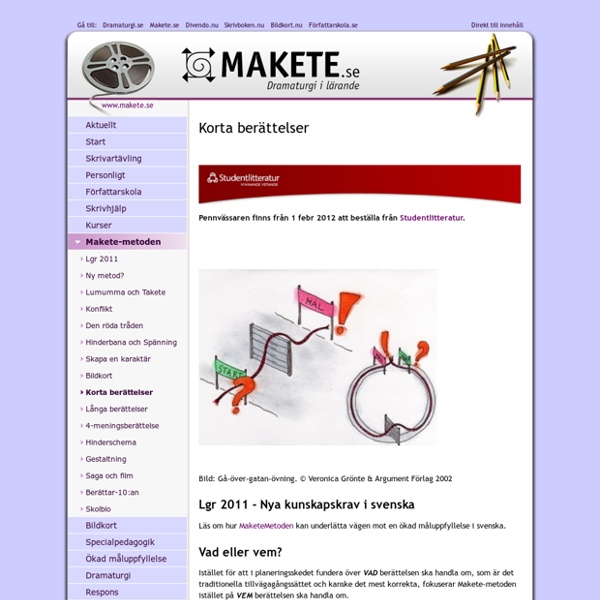Om Sagosidan – Sagosidan
Välkommen till sagosidan! Ett sagobibliotek med klassiska sagor av författare som HC Andersen och med folksagor från hela världen. Dessutom med en blogg om högläsning, berättelser för barn och annat som har med sagor att göra.
Myths, Folktales, and Fairy Tales
Overview Students learn about a genre through participation in a variety of online activities. By interviewing accomplished genre writers and storytellers, taking part in online writing activities, and using interactive technology tools, students delve into the history, meaning, and cultural importance of each distinct genre. NOTE: Please be aware that there may be potentially objectionable material in some traditional myths.
10 Reasons Why Kids Need to Read Non-Disney Fairy Tales
Say “fairy tales” and your mind likely flashes to Disney and its animated versions of children’s classics. But old-school fairy tales — stories by authors such as Hans Christian Andersen, Oscar Wilde, Sophie, Comtesse de Ségur, or Andrew Lang — are filled with a richness and complexity that is often missing from their big-screen renderings. Here are ten reasons it’s worth reading the original stories with your young reader. 1.
Fairy Tale Autobiographies
ReadWriteThink couldn't publish all of this great content without literacy experts to write and review for us. If you've got lessons plans, videos, activities, or other ideas you'd like to contribute, we'd love to hear from you. More Find the latest in professional publications, learn new techniques and strategies, and find out how you can connect with other literacy professionals. More
The Selfish Giant (Oscar Wilde)
One of most beautiful and famous fairy tales by Oscar Wild. The story of a grumpy selfish giant and a little boy who teaches him about a happy life and an eternal spring. An inspirational story to make you think about how you are running your life.
Kunskapsbanken, Grekisk mytologi - Unga Fakta
Grekisk mytologi Vår målsättning och syftet med Kunskapsbanken är att tillhandahålla bra, användarvänligt studiematerial för användning i skolår F-9. att med hjälp av sajten Unga Fakta kunna överföra kunskapen och delar av materialet till konkreta klassrumsprojekt i grupp eller enskilt. att med hjälp av text, bild, film och utskriftsvänliga förslag på klassrumsprojekt, skapa en kreativ skolmiljö med ett upplevelsebaserat lärande som både är lärorikt, utvecklande och roligt. Vi har gått ifrån föregående års upplägg med tre olika handledningar indelat på skolåren F-3, 4-6, 7-9. Istället har vi valt att lägga alla aktiviteter, idéer och pyssel på samma ställe och att efter varje förslag gradera materialet efter svårighetsgrad.
Hans Christian Andersen: The Wild Swans
by AR away in the land to which the swallows fly when it is winter, dwelt a king who had eleven sons, and one daughter, named Eliza. The eleven brothers were princes, and each went to school with a star on his breast, and a sword by his side. They wrote with diamond pencils on gold slates, and learnt their lessons so quickly and read so easily that every one might know they were princes. Their sister Eliza sat on a little stool of plate-glass, and had a book full of pictures, which had cost as much as half a kingdom.
The Little Match Girl by Hans Christian Andersen
Most terribly cold it was; it snowed, and was nearly quite dark, and evening-- the last evening of the year. In this cold and darkness there went along the street a poor little girl, bareheaded, and with naked feet. When she left home she had slippers on, it is true; but what was the good of that? They were very large slippers, which her mother had hitherto worn; so large were they; and the poor little thing lost them as she scuffled away across the street, because of two carriages that rolled by dreadfully fast. One slipper was nowhere to be found; the other had been laid hold of by an urchin, and off he ran with it; he thought it would do capitally for a cradle when he some day or other should have children himself. So the little maiden walked on with her tiny naked feet, that were quite red and blue from cold.
Berättelsearkiv
Det sägs att blommorna var mycket ledsna över att de inte hade något himmelrike. De gick till Skaparen och klagade. Alla andra hamnar i himlen när de dör, sa blommorna. Eller möjligen någon annan stans.
Grekisk mytologi (LättLäst)
Grekisk mytologi (LättLäst) Grekisk mytologi är en samling berättelser. Mytologin och dess berättelser var en del avvardagen i Grekland under antiken. Antiken är en tidsperiod som sträcker sig från3000 år före Kristus till år 500 efter Kristus. Det berättas om gudar, hjältar och monsteri en äventyrlig blandning. Den grekiska mytologin har satt sina spåröverallt ända fram till idag.
Sagor och myter i forntidens Norden
Jordens skapelse • Världsträdet Yggdrasil • VanakrigetOdens jakt på vishet • Kvädet om Trym • Iduns äpplenBalder & misteln • Lokes straff • Ragnarök Mytologin var under forntiden en tradition, som under århundraden muntligt fördes vidare från generation till genration. Utöver ett fåtal, korta runinskriptioner finns det inga bevarade skrifter om mytologin förrän efter kristendomens införande. De tidiga verk, som anses vara de överlägset viktigaste källorna till den forna mytologins värld är den poetiska Eddan och Snorres Edda. Den förstnämna tros vara skriven någon gång under 1200-talet på Island eller i västra Norge, av okänd(a) författare. Den senare är skriven cirka 1220 av Snorre Sturlasson – en isländsk präst, skald och historiker, med hög maktposition.



